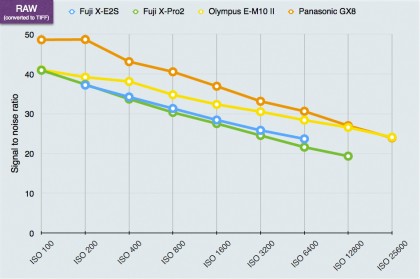Why you can trust TechRadar
The signal to noise ratio compares the level of random digital noise in the image to real image data. The higher the number, the lower the visible noise levels in pictures. The signal to noise ratio is measured in laboratory conditions using DxO Analyzer hardware and software.

JPEG signal to noise ratio analysis: In this test, all four cameras are remarkably evenly matched. The results are so close that you couldn't say any of them had an advantage.

Raw (converted to TIFF) signal to noise ratio analysis: The raw files, though, do start to show some clear differences. The Panasonic has by far the lowest noise levels, despite the relatively small size of its Micro Four Thirds sensor. The Olympus OM-D E-M10 does quite well in second place, and the X-E2S and X-Pro2 are left trailing in last place, with nothing to choose between them.
Sign up for breaking news, reviews, opinion, top tech deals, and more.
